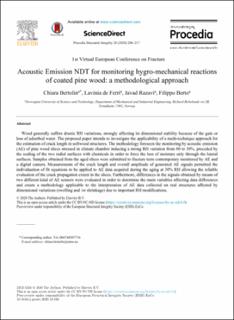| dc.contributor.author | Bertolin, Chiara | |
| dc.contributor.author | De Ferri, Lavinia | |
| dc.contributor.author | Razavi, Seyed Mohammad Javad | |
| dc.contributor.author | Berto, Filippo | |
| dc.date.accessioned | 2021-02-01T09:06:45Z | |
| dc.date.available | 2021-02-01T09:06:45Z | |
| dc.date.created | 2020-12-02T08:54:16Z | |
| dc.date.issued | 2020 | |
| dc.identifier.citation | Procedia Structural Integrity. 2020, 28 208-217. | en_US |
| dc.identifier.issn | 2452-3216 | |
| dc.identifier.uri | https://hdl.handle.net/11250/2725483 | |
| dc.description.abstract | Wood generally suffers drastic RH variations, strongly affecting its dimensional stability because of the gain or loss of adsorbed water. The proposed paper intends to investigate the applicability of a multi-technique approach for the estimation of crack length in softwood structures. The methodology foreseen the monitoring by acoustic emission (AE) of pine wood slices stressed in climate chamber inducing a strong RH variation from 80 to 30%, preceded by the sealing of the two radial surfaces with chemicals in order to force the loss of moisture only through the lateral surfaces. Samples obtained from the aged slices were submitted to fracture tests contemporary monitored by AE and a digital camera. Measurements of the crack length and overall amplitude of generated AE signals permitted the individuation of fit equations to be applied to AE data acquired during the aging at 30% RH allowing the reliable evaluation of the crack propagation extent in the slices. Furthermore, differences in the signals obtained by means of two different kind of AE sensors were evaluated in order to determine the main variables affecting data differences and create a methodology applicable to the interpretation of AE data collected on real structures affected by dimensional variations (swelling and /or shrinkage) due to important RH modifications. | en_US |
| dc.language.iso | eng | en_US |
| dc.publisher | Elsevier | en_US |
| dc.rights | Attribution-NonCommercial-NoDerivatives 4.0 Internasjonal | * |
| dc.rights.uri | http://creativecommons.org/licenses/by-nc-nd/4.0/deed.no | * |
| dc.title | Acoustic Emission NDT for monitoring hygro-mechanical reactions of coated pine wood: a methodological approach | en_US |
| dc.type | Peer reviewed | en_US |
| dc.type | Journal article | en_US |
| dc.description.version | publishedVersion | en_US |
| dc.source.pagenumber | 208-217 | en_US |
| dc.source.volume | 28 | en_US |
| dc.source.journal | Procedia Structural Integrity | en_US |
| dc.identifier.doi | https://doi.org/10.1016/j.prostr.2020.10.026 | |
| dc.identifier.cristin | 1855149 | |
| dc.relation.project | Norges forskningsråd: 274749 | en_US |
| dc.description.localcode | © 2020 The Authors. Published by Elsevier B.V. This is an open access article under the CC BY-NC-ND license (https://creativecommons.org/licenses/by-nc-nd/4.0) | en_US |
| cristin.ispublished | true | |
| cristin.fulltext | original | |
| cristin.qualitycode | 1 | |

